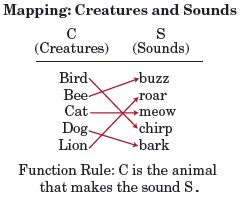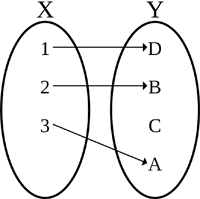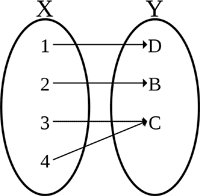Function
A function is a relation between two sets in which each member of the first set is paired with one, and only one, member of the second set.
A function rule is a rule that explains the relationship between two sets.
Example
Two of the ways that functions may be shown are by using mapping (left) and tables (right), shown below.
 |
 |
Functions are also represented algebraically through expressions or equations. These expressions and equations describe the relationship between an independent and a dependent variable.
Example
3x + 4 f(x) = x
Functions can also be drawn as graphs. When represented as graphs, the dependent variable of the function is plotted on the y-axis while the independent variable is plotted on the x-axis. For discrete functions, each point of the function (x,y) is plotted as a coordinate. For non-discrete functions, those points are connected as a line.
Example

On a graph, the vertical line test can be used to determine whether or not a curve is a function. There is also the horizontal line test, which determines whether or not a funcntion is one-to-one. A one-to-one function is defined as a function in which distinct elements of its domain are never mapped to the same element of its co-domain, as shown below:

|

|
On the left is a one-to-one function, also known as an injective function. No X element is mapped to the same Y element. In contrast, the function on the right is a function that is not one-to-one, since two of the X elements, 3 and 4, are mapped to the same Y element, C.
